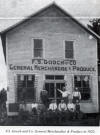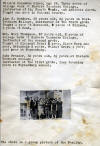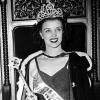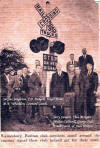
|
Waynesburg, located south of
Stanford, The mail for the community was
carried by Pony Express until 1893. The first
post office was established in 1824. This post office has moved eight times.
Between 1827-28 the post office was closed. A mail route was A stage route was established between Somerset and Stanford. The regular stage stop at Waynesburg was at the Routen Place. Mr. Acton Routin’s father made the last stagecoach run. Some changes came with the railroad. Waynesburg moved from the stagecoach line to its present location by the railroad. The Southern Railroad came through the area in 1880. In the 1890s Dr. A. K.
Caldwell opened his office across the railroad. He served the residents of
Waynesburg for abou There were merchants who owned
stores or businesses by the railroad. They were Dutch Goo The Waynesburg Deposit Bank was built and incorporated in 1907 with a total stock of $75,000. The directors were Jimmie Hayes, President R. Y. Ballard, Clay Elliott, Mrs. L. 0. Gooch and Virgil McKenzie. M. E. Wheeldon, cashier, earned $50 per month and Mr. Mullins, assistant cashier, earned $25 per month. The directors decided to close the bank in 1931 during the Great Depression, but no one lost any money. Waynesburg’s second bank was
opened in 1982 as a branch of Lincoln County National Bank. A mobile unit was first
used
Waynesburg has had three factories. A canning factory, which prepared tomatoes and mo lasses, was located across from the present Ed Buis Furniture Store and north of Dr. G. B. Williams home. They used dogwood to help in making it. Allen Horton ran this factory. It stayed open for two years, and then closed. Singleton’s Mill, shown,
is located in Waynesburg. The second one was a steering wheel factory, located
at the site of the Waynesburg Lumber Company. A Mr. Jones ran it. They made
steering wheels for cars and trucks. It stayed open for two years. The third factory, the Delco
Plant, was in operation in 1918. This
factory remained in operation for a year. Waynesburg had a hotel located
near the rail road called Warriner Hotel and later the Horton Hotel. Salesmen
from all over the country stayed in the hotel. A modern, one story structure,
has replaced the old school. The old gray, stone structure was a two story
with a
basement. Some of the teachers of the Waynesburg School were Oakley Lanhan, R.
H. Playforth, S. M. Cook, Delmar Wallace, G. W. Durr, Mrs. Roy McKeethan,
Faunice Hubble, Leonard Horton, Columbus Hines, Alma Sanders, Mrs. Lavina
Diamond, Ruby Frazier, Mrs. Mary Thompson, Guy Penningt Miss Venus Ramey a former Waynesburg student was selected and crowned as Miss Lincoln County on Sept. 20, 1939 at the Lincoln County School Fair held at Hustonville. Later she entered more beauty contests and became Miss America in 1944. The chimney still stands on
the Calvin Greer farm where the first school was held. The Masonic Lo Our town has been supported by many businesses and civic organizations. One of the leading contributors has been the local Ruritan Club. Our latest organization, the Waynesburg Area Rescue Squad, has played a very important part since it began in January of 1974. The quality of our heritage has sustained us and will be our guide and inspiration down through the coming years.
UNION ARMY IN WAYNESBURG A stop over in Waynesburg in November 1863 resulted in 13 local men being added to the ranks of the 49 Regiment of the Kentucky Infantry of the Union Army. Col. John G. Eve commanded the 49th; ac cording to the Adjutant General’s Report on the Civil War in Kentucky. His second in command was Lt. Col. Philos Stratton. The regiment was originally formed as a cavalry unit but due to a shortage of horses was relegated to infantry duty. However, several of the men would later achieve their desire to in the cavalry when they transferred to the lst KY Cavalry. The Adjutant’s report does not provide a great deal of details concerning the 49 role in the war except to say the entire unit would make camp at Camp Burnside in Pulaski County. The stop in Waynesburg came over a year after the major fighting in Kentucky had ended In October 1862, Confederate Gen. Braxton Bragg left Kentucky after the Battle of Perryville. His departure ended most of the large scale fighting in the state. However, the war sill raged throughout the Bluegrass as Union home guard troops fought off guerrilla attacks. which were for the most part, led by Confederate flea John Hunt Morgan of Lexington. Records indicate that at least one company of the 49th spent time in Waynesburg. All l3 of the men mustered in the Union Army Waynesburg on Nov. 4, 1863, were placed Company “D” under Capt. John. M. Cook. William Carson was the company’s first lieutenant and Henry S. Branaman was second Lieutenant. Only two of the men, who were mustered in at Waynesburg, rose above the rank of private John R. Hicks achieved the rank of sergeant and John W. Berry became a corporal. Hicks served in the 49th until Jan. 15, 1861 when he transferred to the 19TH Kentucky Inf. Six of the 11 privates who joined the Union cause in Waynesburg also transferred out of company on April 7, 1864. All six became members of the 7 Kentucky Cavalry. Those six were: James W. Durham, James H. Durham, Geo. W. Darrel, John Giles, Charles R.and Joseph M. Reynolds. Five of the privates mustered in Nov. 4th, 1863, at Waynesburg followed suit and ended their service in the war on Dec. 26th, 1864, in Lexington. Those five men were Geo.W. Abbott, Joshua Boering, Elijah, Wm. M. Hayes and John C. Hicks. The records of company “D” show that of its members died while in the service of regiment and seven were listed as deserters. However, none of the Waynesburg men were killed and to their credit, none deserted. By David Gambrel
|

 was named in honor of General Anthony Wayne, a Revolutionary War hero.
The town was settled in the early 1800s. According to the Lincoln County Deed
Books, the early settlers were as follows: Singletons, Reynolds, Gouaches,
Caldwell's, Trowbridges, Barnetts, Estes, Morgans, Lees, McMullins, Leaches,
Sweeneys, Youngs, Williams, Padgetts, McKinneys, Smiths, Jacobs, Bastins,
Hortons, Sims, Mitchells, Ellisons, Lanigans, Campbells and Routins.
was named in honor of General Anthony Wayne, a Revolutionary War hero.
The town was settled in the early 1800s. According to the Lincoln County Deed
Books, the early settlers were as follows: Singletons, Reynolds, Gouaches,
Caldwell's, Trowbridges, Barnetts, Estes, Morgans, Lees, McMullins, Leaches,
Sweeneys, Youngs, Williams, Padgetts, McKinneys, Smiths, Jacobs, Bastins,
Hortons, Sims, Mitchells, Ellisons, Lanigans, Campbells and Routins.








